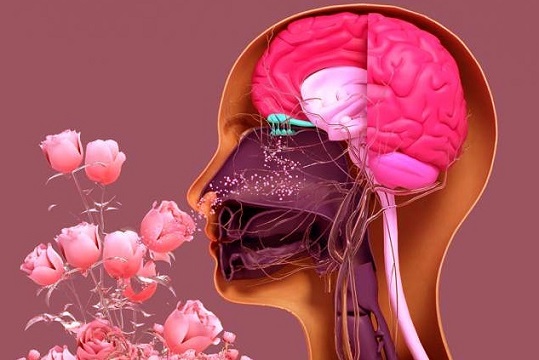Differences in Long COVID Olfactory Loss and Other Postviral Olfactory Disorders
Nikhil Prasad Fact checked by:Thailand Medical News Team Jan 17, 2025 3 months, 1 week, 2 days, 5 hours, 2 minutes ago
Medical News: The COVID-19 pandemic left countless people around the world grappling with lingering symptoms long after the acute infection subsided. Among these, long-term olfactory dysfunction - or smell loss - has become a significant concern. A recent study by researchers from Beijing University of Chinese Medicine and the China-Japan Friendship Hospital provides new insights into the differences between olfactory dysfunction caused by COVID-19 (Long COVID Olfactory Dysfunction, LCOD) and non-COVID postviral olfactory dysfunction (NCPVOD). Their findings shed light on distinct mechanisms and potential treatment strategies for persistent olfactory impairment.
 Differences in Long COVID Olfactory Loss and Other Postviral Olfactory Disorders
Olfactory Dysfunction: A Persistent Problem
Differences in Long COVID Olfactory Loss and Other Postviral Olfactory Disorders
Olfactory Dysfunction: A Persistent Problem
COVID-19-related olfactory dysfunction is often one of the first symptoms experienced by infected individuals. Reports suggest that between 40% and 85% of COVID-19 patients lose their sense of smell. While many recover within weeks, a significant portion - approximately 5.6% to 12.8% - experience long-lasting symptoms, with some still affected years later. This
Medical News report examines the findings of the study, which compared LCOD to NCPVOD, a condition typically caused by viruses such as influenza or rhinovirus. While both conditions lead to smell loss, they differ in onset, recovery patterns, and physiological mechanisms.
How the Study Was Conducted
Researchers conducted a retrospective analysis at the China-Japan Friendship Hospital. Between February 2023 and July 2024, they examined 70 patients: 35 with LCOD and 35 with NCPVOD. All participants underwent high-resolution MRI scans targeting the olfactory pathway, as well as psychophysical tests like Sniffin' Sticks and visual analogue scales (VAS) to evaluate their sense of smell. These methods allowed researchers to assess parameters such as the opacity of the olfactory cleft (OC), the volume and morphology of olfactory bulbs (OB), and the depth of the olfactory sulcus.
Key Findings on Olfactory Pathway Differences
The study uncovered several noteworthy differences between LCOD and NCPVOD patients:
-Olfactory Cleft Opacity: Patients with LCOD exhibited significantly higher olfactory cleft opacity scores compared to those with NCPVOD. This finding suggests that inflammation in the olfactory cleft might play a more prominent role in COVID-related smell loss.
-Olfactory Bulb Volume: Both groups demonstrated reduced OB volumes, a condition linked to long-term olfactory dysfunction. However, no significant differences were found between the groups, reinforcing the idea that OB atrophy is a common outcome of viral infections.
-Olfactory Sulcus Depth: LCOD patients showed a greater depth in the right olfactory sulcus compared to NCPVOD patients. This lateralized structural alteration could indicate unique effects of COVID-19 on the olfactor
y pathway.
-Correlation with Age: OB volume and olfactory sulcus depth were negatively correlated with age, meaning older patients were more likely to show structural changes and smell loss.
What These Differences Mean
The findings highlight that inflammation in the olfactory cleft - a specific feature of LCOD - may obstruct odorant molecules from reaching the olfactory bulb, exacerbating smell loss. Additionally, the observation of OB volume reductions in both groups underscores the potential for long-term olfactory nerve damage following viral infections.
Interestingly, the right-sided olfactory sulcus depth difference suggests a lateralized effect of COVID-19 on the olfactory system. Prior research has shown that the right olfactory bulb often exhibits greater activity than the left, which might explain the significance of this finding. By focusing on these structural changes, the study adds a layer of understanding to the mechanisms behind persistent smell loss.
Implications for Treatment
One of the most promising aspects of this research is its potential impact on treatment strategies. Since inflammation appears to play a central role in LCOD, targeting the olfactory cleft with anti-inflammatory therapies could improve outcomes for these patients. Past studies on corticosteroids have yielded mixed results, but the current findings suggest a more targeted approach could enhance efficacy. Similarly, interventions aimed at stimulating olfactory bulb regeneration may benefit patients with OB atrophy.
Study Limitations and Future Directions
While the study provides valuable insights, it also has limitations. The absence of a healthy control group prevents direct comparisons with individuals without olfactory dysfunction. Additionally, the reliance on cross-sectional imaging limits the ability to observe changes over time. Future studies with longitudinal data and larger sample sizes could help validate and expand these findings.
The researchers also propose exploring novel MRI-based diagnostic tools to predict which patients are most likely to benefit from specific treatments. By integrating advanced imaging techniques, clinicians may be able to tailor interventions more effectively.
Conclusions
The study provides critical insights into the differences between LCOD and NCPVOD, emphasizing the role of inflammation and structural changes in long-term olfactory dysfunction. By identifying distinct patterns of olfactory pathway damage, the research highlights potential avenues for targeted treatments, such as anti-inflammatory therapies and interventions to stimulate nerve regeneration.
These findings not only deepen our understanding of postviral olfactory dysfunction but also pave the way for more personalized and effective treatment options.
For individuals suffering from long-term smell loss, these discoveries bring hope of improved therapies and better quality of life. Continued research is essential to refine these approaches and uncover additional mechanisms underlying persistent olfactory dysfunction. With further advancements, it may become possible to prevent or reverse the debilitating effects of viral-induced smell loss altogether.
The study findings were published in the peer-reviewed journal: Frontiers in Neurology.
https://www.frontiersin.org/journals/neurology/articles/10.3389/fneur.2024.1535699/full
For the latest COVID-19 News, keep on logging to Thailand
Medical News.
Read Also:
https://www.thailandmedical.news/news/genetic-insights-into-persistent-loss-of-smell-after-covid-19
https://www.thailandmedical.news/news/new-discovery-links-loss-of-smell-in-covid-19-to-epigenetic-changes
https://www.thailandmedical.news/news/cerebral-microstructural-changes-linked-to-cognitive-olfactory-and-fatigue-symptoms-in-post-covid-condition
https://www.thailandmedical.news/news/breaking-sars-cov-2-causes-type-i-interferon-signaling-dysregulation-in-olfactory-networks-with-implications-of-risk-for-alzheimer-s-disease
https://www.thailandmedical.news/news/egyptian-randomized-trial-finds-that-cerebrolysin-peptides-from-pig-brains-can-treat-post-covid-19-olfactory-gustatory-and-chemosensory-dysfunctions
https://www.thailandmedical.news/news/omicron-variant-directly-penetrates-the-cns-via-the-olfactory-bulb-causing-inflammation-and-neuronal-damage
https://www.thailandmedical.news/articles/coronavirus
